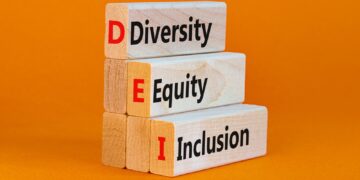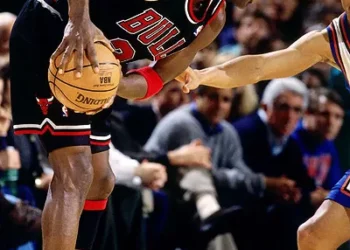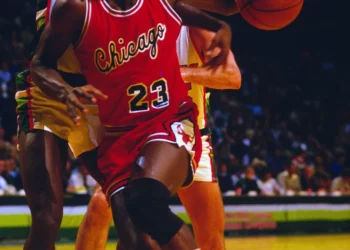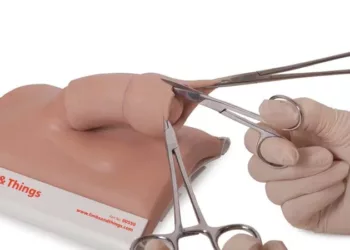Playing basketball for the first time brings a mix of excitement and uncertainty. Mastering essential skills like dribbling, passing, and shooting to become a competent player can seem daunting.
But breaking down basketball’s core techniques into step-by-step detail makes excelling in the sport more achievable. Understanding key rules and player positions allows you to communicate fluently on the court. Most importantly, appropriate drills let you hone skills with real-game intensity to get up to speed quickly.
This complete guide aims to accelerate your basketball learning curve with actionable instruction. You’ll gain the technical and tactical knowledge to play with confidence while avoiding common beginner pitfalls.
Starting from Scratch: Must-Know Basketball Basics
Before diving into positional play concepts, start by building general sports skills that translate well to basketball:
Cardiovascular Endurance – Basketball is extremely fast-paced, requiring running back and forth for 30-40 minutes. Jogging, biking, and interval training develops stamina so you can maintain active participation without getting overly fatigued.
Leg Power – Jumping for rebounds and sprinting up and down the court demand explosive leg strength. Squats, lunges, box jumps and plyometrics lead to greater speed and vertical leap ability.
Agility – Basketball involves constant starting, stopping, changing direction and reacting. Ladder drills and cone exercises build coordination and body control.
Balance/Stability – Given inevitable contact and physicality in basketball, a strong core prevents you from getting pushed around easily while promoting fluid lateral movement. Planks, Russian twists, and single-leg stability exercises pay dividends.
Building an athletic base through versatile, full-body conditioning gives you the tools to positively impact a game right away, even as your skill development remains a work in progress.
Mastering Core Basketball Skills and Techniques
When stepping on the basketball court for the first time, initially focus on improving essential ball handling and scoring skills through purposeful repetitions.
Dribbling
Maintaining control of the basketball via competent dribbling technique lets you move confidently around the floor while protecting possession:
- Use just your fingertips to push the ball firmly to the ground, rather than dribbling with your palm or whole hand. Keep wrists stiff.
- Dribble at waist height or below. Any higher and defenders can easily swipe the ball away.
- Look forward toward where you intend to go rather than staring down at the ball. Scanning the court allows you to react and change direction.
- Incorporate pace changes and misdirection. Hesitation moves, crossovers, behind the back and between the legs dribbles keep defenders guessing.
Use visual landmarks like chalk or cones to practice straight line sprint dribbling, stopping and changing direction, and mastering advanced moves through drill progressions.
Passing
Whether executing a designed play or moving the ball to find an open shooter, accurate passing unlocks basketball’s kinetic beauty.
Chest Pass
- Stand in athletic position with feet shoulder-width apart
- Bring the ball to your chest, keeping elbows out
- Step toward target, pushing ball firmly from chest
- Snap wrists at point of release
- Follow through motion
Bounce Pass
- Ideal for passing around nearby defenders
- Aim just in front of teammate to allow for bounce reception
- One handed push downward combining wrist snap and finger extension
Overhead Pass
- Both hands on sides of ball overhead
- Flick the wrist while extending elbow to generate velocity
- Allows for passing over defenders
Test passing accuracy starting stationary, then add movement. Vary distance and drill difficulty by passing to various court locations.
Shooting
Putting the ball through the hoop requires proper mechanics to be a consistently reliable scoring threat.
Key Shooting Tips:
- Athletic stance with feet shoulder-width apart
- Grip ball in fingertips of shooting hand, guide hand stabilizing side
- Dip down into knees to generate power
- Extend arm fully while flicking wrist for optimal arc
- Hold follow-through position with wrist curled downward
- Land balanced, ready to rebound
When first learning, begin close to the basket, focusing on proper shooting form and footwork. As technique improves, gradually increase distance while practicing shots on the move.
Perform spot shooting from various court locations relevant to game situations – wing 3-pointers, top of the key, elbow jumpers, reverse layups, etc. Also rapid fire jump shots to engrain mechanics through repetition.
Table 1. Basketball Skills Table for Beginners
| Skill | Technique Tips | Drills/Exercises |
|---|---|---|
| Dribbling | Use fingertips, Keep the ball low, Look up, Vary pace/direction | Foundational drills, Cone dribbling, Figure 8’s |
| Passing | Chest pass, Bounce pass, Overhead pass, Baseball pass | Wall passing, Two-line passing, Passing circle |
| Shooting | Proper form, Flick wrist, Follow through | Close range, Free throws, Jump shots |
Running Effective Basketball Drills
Practicing skills individually in isolation will only take you so far. Adding dynamic drills provides a bridge to execute those abilities in simulated game situations. As a basketball beginner, focus initially on drills that reinforce proper fundamentals.
Mikan Drill
- Named after Hall of Fame center George Mikan
- Under the basket, alternate making right and left handed layups off the backboard
- Develops footwork, touch, and ambidextrous finishing
5 Spot Shooting
- Arrange 5 cones/markers around arc – top of key and each elbow and wing
- Sprint around perimeter moving to touch each spot. Shoot jump shot when arriving at next marker.
- Builds conditioning, ball handling, perimeter shooting
Defensive Slides
- Drop step sideways leading with the foot closest to intended direction
- Keep knees bent and butt down with weight forward, ready to react
- Drive legs outward explosively to change direction
- Use resistance band for added intensity
Increase your learning speed by consistently applying key skills within dynamic shooting, dribbling, passing and defensive drills. As execution improves, pick up the pace and complexity.
Understanding Common Basketball Rules and Positions
As a basketball novice, initially the game looks chaotically fast and physical. But there is underlying structure within standard rules and strategic player rotations aimed to balance spacing, skillsets and matchups.
Key Basketball Rules
While certainly not an exhaustive list, these basketball rules provide a solid grounding:
Traveling – Once halting dribble, players cannot take extra steps without dribbling again or passing. Pivoting with one foot planted is allowed.
Double Dribble – Cannot dribble with two hands simultaneously or pick up dribble before starting again. Goaltending – Touching ball illegally while on downward flight toward basket.
Three Seconds in the Key – Offensive players cannot be inside key area near basket for over 3 seconds unless actively attempting a shot.
Jump Ball – Referee tosses ball up between two opponents to resume action after a held ball or other stoppage. Possession arrows often decide direction.
Basket Interference – Touching ball illegally while inside or directly above cylinder area.
Free Throws – Awarded for shooting fouls and some non-shooting fouls.
As the initiator of rules at the original YMCA, basketball legend James Naismith famously said, “Basketball is a game that should be learned through cooperation rather than confrontation.” So embrace proper etiquette while learning nuances organically through court time.
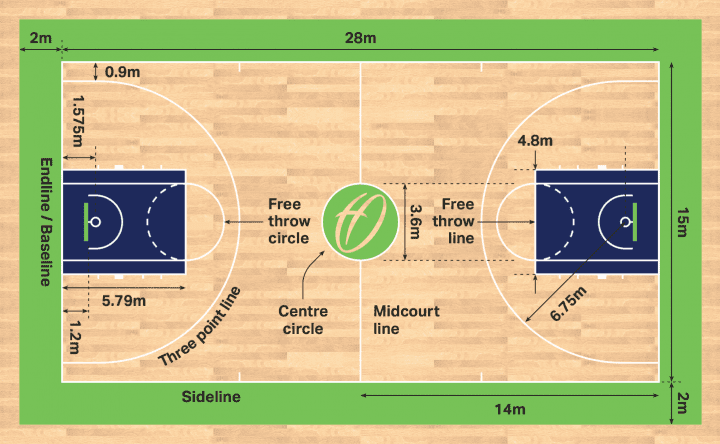
Basketball Positions
Each of the five positions serve unique strategic roles based on common physical attributes and responsibilities:
Point Guard
- Takes ball up court to orchestrate offense
- Calls out plays while directing teammates
- Looks to pass first but can drive to the basket when overplayed
Shooting Guard
- Typically the most consistent perimeter shooter
- Curls off screens for catch-and-shoot jumpers
- Underrated driver, finisher at the rim
Small Forward
- Utility position providing scoring, defense, rebounding
- Athleticism allows defending multiple positions
- Versatility to shoot from outside or finish inside
Power Forward
- Physical defenders who protect the rim
- Rebounding presence on both ends
- Displays inside/outside scoring ability
Center
- Tallest player provides interior defensive anchor
- Strong rebounder able to finish near basket through contact
- Sets screens to free up teammates
Learn more about typical responsibilities so you understand positioning orientation and funnel into roles that align with your growing skillset.
Staying Motivated as a Basketball Beginner
Learning basketball fundamentals takes considerable time and repetition. With so many intricacies around skills, rules and strategy, frustration is inevitable. Here is some guidance to stay motivated while falling in love with playing basketball:
Enjoy the process rather than fixating on outcomes – Instead of tying self-worth to makes and misses or wins and losses, take pride in shot technique improvements or increased dribbling fluidity through practice.
Record your progress – Quantifying competency gains over time provides tangible evidence of growth rather than just perceiving day-to-day fluctuations. Tracking shooting percentages, completed drills, or cardio benchmarks fuels motivation.
Gather inspiration online – When persistence wavers, find fresh inspiration watching basketball development videos on YouTube. Seeing ordinary people slowly blossom into competent players reinvigorates your own journey.
Play for pure enjoyment – While competition can certainly be stimulating long-term, initially just soak up the joy of playing this fast-paced, dynamic game. As your skills and instincts improve, then dial up competitiveness.
Surround yourself with passionate players – Joining local leagues, clinics and meet-up groups connects you with like-minded individuals. Their enthusiasm and encouragement rubs off while learning together.
The road to basketball excellence starts with building competence in fundamental skills through purposeful repetitions. Regularly testing abilities in dynamic drills engrains proper mechanics and reactions. Developing general athleticism and stamina prepares your body for the game’s physical rigors.
Learning strategic nuances around common rules and player positions allows you to communicate fluently on the floor. Most importantly, stay intrinsically motivated in the early days by enjoying small wins and surrounding yourself with others basking in the sport.
Now equipped with complete instructional detail for every step of the basketball journey, grab a ball and get rolling toward proficiency one dribble at a time!
Personal Note
I started playing organized basketball in elementary school and instantly fell in love with the fast pace of the game. Sure, I tripped over my own feet plenty of times while learning how to dribble! But the more I practiced, the better my skills became. My proudest moment came sinking a game winning basket as time expired in a close game in middle school – the ball going straight through without touching rim!
Now decades later, I still play regular pick-up games for the exercise, camaraderie, and self-competition. That pure joy I felt as a beginner never faded over time. I hope this beginner’s guide to mastering basketball gives you the blueprint to confidently develop new skills as the foundation for a lifelong basketball journey!
Let me know in the comments about your basketball progress! What skills are you currently working on? What drills are helping improve your game? Do you have any other basketball tips for beginners?





























